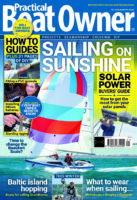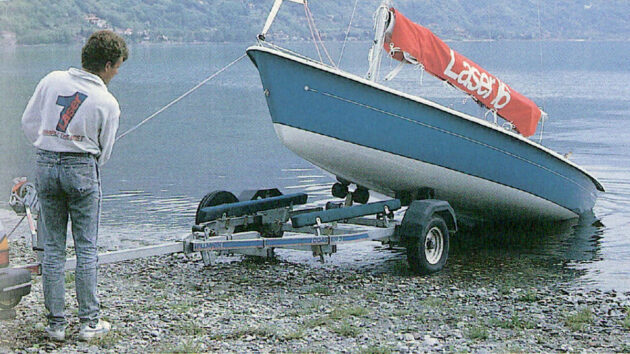At last, a proper trailer sailer, says Wendy Fitzpatrick of the Laser 16 cruising dinghy, in a review for the December 1987 issue of Practical Boat Owner
If anyone had tried to tell me a week ago that a new 16ft day sailer/weekender would fill a gap in the sailing dinghy market I would have been a trifle sceptical, writes Wendy Fitzpatrick in the December 1987 issue of PBO.
Not that anyone did try to tell me any such thing, of course.
But, confronted with a phone call from the Laser people to tell me about their brand new 16ft Laser Weekender recently launched on the market and which was just dying for a PBO boat test, couldn’t I be forgiven for thinking that here, at last, might be a very real challenge to the evergreen Wayfarer?
The Laser singlehander carved itself a market where everybody assumed saturation point had been reached and now, 130,000 boats later, the design is still going strong.
It would not surprise me if the Laser 16 enjoyed a comparable success story, bearing in mind the extra size and cost of the boat.
Impressive handling
At 16ft 7in she’s actually nearer 17ft than 16ft but she has the feel of an even bigger boat.
Possibly the best way to describe her is to say that she could be a modern, streamlined version of the traditional 18ft dayboats like the National 18.
Her glassfibre construction is robust throughout and her lines manage to be at one and same time chunky and sleek with deceptively high freeboard.
Her clean layout was, in our experience, entirely snag-free and there’s freedom, too, from the chore for which so few families find the time: traditional maintenance.
Afloat, she handles like a big boat.
Ashore, she’s sufficiently compact to be managed easily.
A few years ago we were told that trailer-sailers were the rage. They proliferated at boat shows.
Trailer manufacturers had a field day producing new shapes for new hulls. But where are they all now?
Could it be that they were just too big for the average suburban driveway; their accommodation just a little too cramped for the English climate; their sailing performance just a little less sparkling than the dinghies from which their devotees were supposed to emerge?
For my money, the Laser 16 is a really worthwhile trailer-sailer.
She needs no more than a medium-sized family saloon by way of pulling power and her custom-made galvanised trailer is robust and functional.
Laser 16 boat test
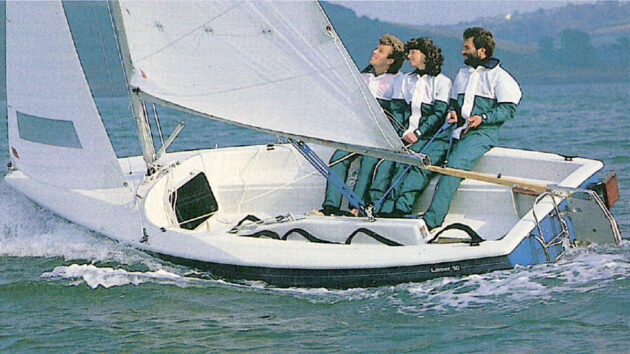
Laser 16 trailer sailer boat test – from the December 1987 issue of Practical Boat Owner. Photo credit: Wendy Fitzpatrick
We launched her in less-than-perfect conditions and recovered her at low water using a slipway so slippery we dare not take the car on it.
Conscious that in most circumstances the manoeuvre will be undertaken by a husband and wife team with the children and family dog offering more hindrance than help, I stationed myself on the winch handle while husband Mike and Richard Simmonds of The Laser Centre tried to pretend that they were really only one person as they guided the boat on to her chocks.
With practice, and given reasonable launching conditions, there’s no reason why launching and recovery should not be free from trauma for a husband and wife.
I liked the provision of webbing, rather than wire, for the trailer’s winch.
Of course, you could always keep her on a mooring in sheltered river or harbour conditions.
Like her small sister, the Laser Fun, the 16 has a two-part mast, sleeved at the hounds and with streamlined anchorages for forestay and shrouds.
The idea behind this is that the mast can be lashed to a roofrack, or even to the boat itself, for trailing and becomes very much more easily handled in two short lengths.
It retains internal halyards and the sleeving/unsleeving process is pretty well foolproof.
Blessed with a very brisk sailing wind for our test we were, by the same token, confronted with a wave-lashed slipway and onshore wind for the launch.
We had precious little manoeuvring space between the slipway and the harbour wall so we decided to motor out into clear water before hoisting the sails.
A rather tongue-in-cheek decision, and one which I would have been reluctant to make without the sheet of the furling jib at the ready.
In the event, the little 4hp Mariner coped manfully with the conditions, pushing our bucking bronco steadily into the teeth of the kind of weather which those who sail purely for pleasure are unlikely to meet.
Sailing performance
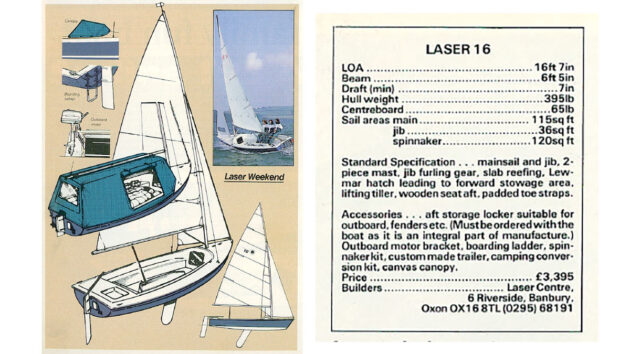
Being three-up, we opted for full rig from the start and were delighted with the performance of the 16.
Like the Laser singlehander, she comes from the board of Bruce Kirby and has the look and the feel of a well-designed thoroughbred.
Resisting, for a while at least, the temptation to sit the boat out hard, sheet in and see how fast we could drive her, we put ourselves in the position of the family afloat.
We found her perfectly manageable with someone sitting to leeward, and so stable that Richard happily wandered around the foredeck while we were driving hard on a reach without the slightest upset to the helm or the boat’s trim.
Then, caution prevailing, we emulated our proverbial family’s decisions and put in a reef.
There are two rows of slab reefing points in the mainsail and a cunning elastic lacing to keep the excess sailcloth in check when reefed.
Under full rig, the boat had heeled to a point which was well short of alarming then she had stiffened up.
With a reef in, the tiger was tamed.
We were still sailing very fast but the bite had been taken out of the mainsail.
We went one stage further and rolled up the jib completely.
Bare-headed, she was perfectly well behaved. The amount of helm required was minimal her responses positive.
The reefs were taken in and shaken out easily under way.
On our boat, a neat RWO jib roller was fitted: an excellent, lightweight fitting and one which is easily to handle provided the control line kept cleated.
Neat features
Perhaps the biggest surprise of this boat was her self-draining cockpit.
One tends to think of the dayboat/weekender as a “sit-in” genus and it is possible that a relatively shallow cockpit will not appeal to everybody.
Personally, I would trade a few inches of footwell for a dry cockpit and the knowledge that, if a capsize should occur, the boat will not become waterlogged.
It’s a clean cockpit layout, with a smoked Perspex hatch in the forward bulkhead to a dry stowage area.
A proofed fabric stowage bag in the cockpit itself takes care of halyard tails and the sun tan lotion.
Aft, there’s an option of a “wet” stowage tank (the cockpit drains through this area via neat Mylar flaps on the transom) or an open area with wooden aft thwart.
Padded toe straps are fitted as standard and the tiller lifts.
Una rig was originally an option, with the mast stepped further forward, but our experience of sailing the boat bare-headed would make us reluctant to go to that much trouble.
Rolling up the jib is so easy.
At the other end of the scale, a spinnaker kit is available.
With a 651b centreboard and a very stable hull, the Laser 16 is not the type of boat which is expected to be capsized.
However, mistakes are made and a dip in the briny isn’t a disaster.
She is, like any big boat, hard work to right, but the reward is that she comes up dry and ready to sail away.
The centreboard is fully retracting and the rudder lifts, to allow easy beaching and exploration of the shallows.
One nice touch is the swimming ladder which fits neatly on the transom and folds up when not required.
For weather protection there’s a cockpit canopy and a complete cockpit camping tent with windows and roll-up door which gives surprisingly roomy overnight accommodation.
Verdict
The basic price is £3,395.
A lot of boat for not a lot of money.
l’d love one. I suspect that sailing schools and holiday companies will, too.
And if the racing boys get their hands on them … Well, why not?
It doesn’t detract in the slightest from the boat’s appeal as a high-performance family weekender.
Specifications
LASER 16
LOA: 16ft 7in
Beam: 6ft 5in
Draft (min): 7in
Hull weight: 3951b
Centreboard: 651b
Sail area main: 11 5sq ft
- jib: 36sq ft
- spinnaker: 120sq ft
Standard Specification: mainsail and jib, 2-piece mast, jib furling gear, slab reefing, Lewmar hatch leading to forward stowage area, lifting tiller, wooden seat aft. padded toe straps.
Accessories: aft storage locker suitable for outboard, fenders etc. (Must be ordered. with the boat as it is an integral part of manufacture.) Outboard motor bracket, boarding ladder, spinnaker kit, custom made trailer, camping conversion kit, canvas canopy.
Price: £3,395
Builders: Laser Centre
Want to read more articles like this?
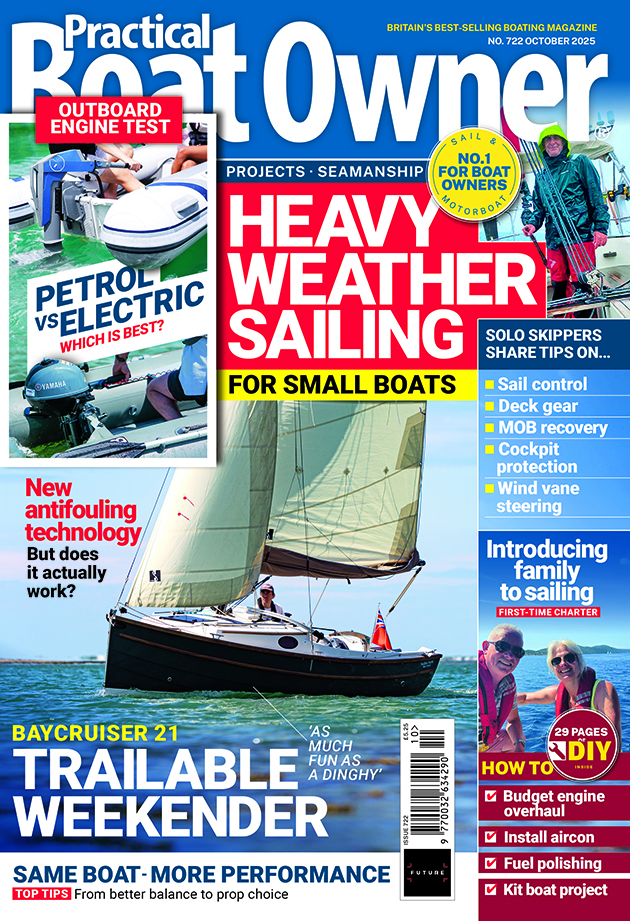
A subscription to Practical Boat Owner magazine costs around 40% less than the cover price.
Print and digital editions are available through Magazines Direct – where you can also find the latest deals.
PBO is packed with information to help you get the most from boat ownership – whether sail or power.
-
-
-
- Take your DIY skills to the next level with trusted advice on boat maintenance and repairs
- Impartial, in-depth gear reviews
- Practical cruising tips for making the most of your time afloat
-
-
Follow us on Facebook, Instagram, TikTok and Twitter

